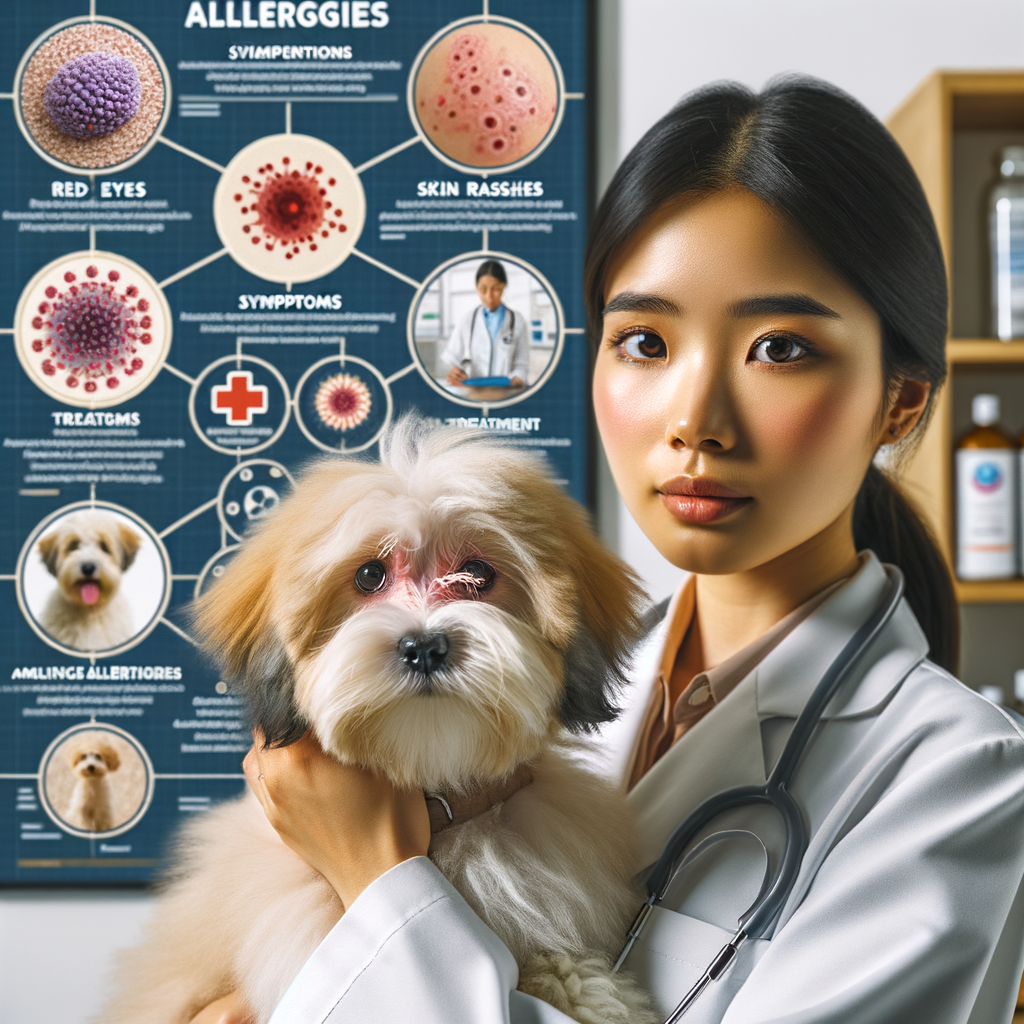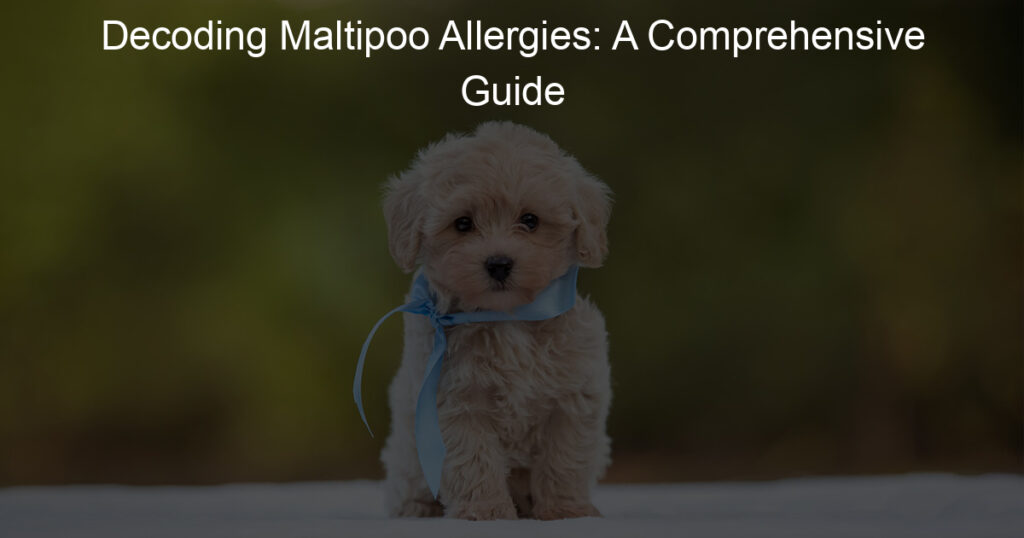
Introduction to Maltipoo Allergies
As a Maltipoo owner or someone considering adopting this adorable breed, it’s essential to understand the potential health issues they may face. One common concern is allergies. In this blog post, we’ll delve into the world of Maltipoo allergies, helping you understand what they are, how to recognize them, and what you can do to help your furry friend.
- Understanding Dog Allergies
- Allergic Reactions in Maltipoos
Allergies in dogs, just like in humans, are the body’s overreaction to certain substances, known as allergens. These allergens can be anything from pollen and dust mites to certain foods or materials. When a dog is exposed to an allergen, their immune system responds by releasing chemicals that cause allergy symptoms. It’s important to note that not all dogs will react to the same allergens, and some may not have allergies at all.
Maltipoos, a crossbreed of Maltese and Poodles, can inherit allergies from either parent breed. These allergies can manifest in a variety of ways, including skin irritation, digestive issues, and respiratory problems. It’s crucial to recognize these symptoms early to provide your Maltipoo with the necessary care and treatment. We’ll explore these symptoms in more detail in the next section of this blog post.
Understanding Maltipoo allergies is the first step to ensuring your pet’s health and happiness. As we move forward, we’ll delve deeper into the causes, symptoms, and treatment options for Maltipoo allergies. Stay tuned to learn more about managing these allergies and ensuring your Maltipoo lives a comfortable, joyful life.
Recognizing Maltipoo Allergy Symptoms
As a Maltipoo owner, it’s important to be aware of the common signs of allergies in dogs and specific symptoms that are unique to the Maltipoo breed. This knowledge will help you take swift action and seek professional help when necessary. Let’s delve into these symptoms.
- Common Signs of Allergies in Dogs
All dogs, regardless of their breed, can exhibit certain general signs when they are suffering from allergies. These include:
- Excessive scratching or licking
- Red, inflamed skin
- Chronic ear infections
- Watery eyes
- Sneezing
- Vomiting or diarrhea
These symptoms can indicate a range of health issues, not just allergies. Therefore, it’s crucial to consult with a vet if you notice any of these signs in your Maltipoo.
- Specific Symptoms of Maltipoo Breed Allergies
Maltipoos, a crossbreed of Maltese and Poodles, can also exhibit specific allergy symptoms. These are:
- Unusual hair loss or bald patches
- Constant paw chewing
- Unusual aggression or irritability
- Excessive rolling on the floor or furniture
These symptoms are often a result of skin irritation caused by allergies. If your Maltipoo shows any of these signs, it’s likely that they’re experiencing discomfort and need immediate attention.
Remember, early recognition of these symptoms can lead to quicker diagnosis and treatment, ensuring your furry friend stays happy and healthy. Always consult with a professional if you suspect your Maltipoo has allergies.
Causes of Maltipoo Allergies
Understanding the causes of Maltipoo allergies is the first step to managing them effectively. One of the primary causes of these allergies is environmental factors. Let’s delve into these factors and how they affect our furry friends.
Environmental Factors
Environmental factors are a significant cause of allergies in Maltipoos. These factors can be categorized into two main groups: outdoor allergens and indoor allergens.
- Outdoor Allergens
- Indoor Allergens
Outdoor allergens are substances found outside that can cause an allergic reaction in Maltipoos. These include pollen from trees, grasses, and weeds, as well as mold spores and dust mites. When Maltipoos come into contact with these allergens, they can develop symptoms such as itching, sneezing, and watery eyes. It’s important to note that these allergens can vary depending on the time of year and the region you live in.
Indoor allergens, on the other hand, are substances found inside your home that can trigger an allergic reaction in Maltipoos. These include dust mites, mold spores, and pet dander from other animals. Other common indoor allergens are certain cleaning products and perfumes. These allergens can cause similar symptoms to outdoor allergens, and in some cases, they can lead to more severe reactions. Regular cleaning and proper ventilation can help reduce the presence of these allergens in your home.
In conclusion, environmental factors play a significant role in causing allergies in Maltipoos. By understanding these factors, you can take steps to reduce your pet’s exposure to these allergens and manage their symptoms more effectively.
Dietary Factors
Just like humans, Maltipoos can also have food allergies. These allergies can cause discomfort and health issues for your furry friend. Let’s explore the common food allergens and how to identify if your Maltipoo has a food allergy.
- Common food allergens for Maltipoos
- Grains: Wheat, corn, and other grains can cause allergies in some Maltipoos.
- Dairy: Some Maltipoos may be lactose intolerant or allergic to other dairy products.
- Protein: Certain types of protein, like beef or chicken, can also be problematic.
- Soy: Soy is another common allergen for dogs, including Maltipoos.
- How to identify a food allergy
- Itching: If your Maltipoo is constantly scratching or biting its skin, it could be a sign of a food allergy.
- Redness: Red, inflamed skin is another common symptom of food allergies in dogs.
- Stomach issues: Diarrhea, vomiting, or changes in appetite can also indicate a food allergy.
- Ear infections: Frequent ear infections may be a sign of a food allergy in your Maltipoo.
Maltipoos, like other dogs, can be allergic to a variety of foods. Some of the most common food allergens include:
Remember, every Maltipoo is unique, and what causes an allergic reaction in one may not in another. It’s crucial to monitor your pet’s reaction to different foods and consult with your vet if you suspect a food allergy.
Identifying a food allergy in your Maltipoo can be challenging, but there are some signs you can look for. These include:
If you notice any of these symptoms, it’s important to consult with your vet. They can help identify the cause of the allergy and recommend a suitable diet for your Maltipoo.
Treatment for Maltipoo Allergies
When it comes to treating allergies in Maltipoos, there are a variety of options available. These range from over-the-counter medications to prescription treatments. It’s important to consult with a vet to determine the best course of action for your furry friend.
Medical Treatments
Medical treatments are often the first line of defense against allergies in Maltipoos. These can be divided into two main categories: over-the-counter medications and prescription treatments.
- Over-the-counter medications: These are readily available and can provide immediate relief from allergy symptoms. They include antihistamines, which can help reduce itching and inflammation, and corticosteroids, which can help reduce inflammation and swelling. It’s important to remember that while these medications can provide temporary relief, they don’t address the underlying cause of the allergies.
- Prescription treatments: These are prescribed by a vet and are often used when over-the-counter medications aren’t enough. They can include stronger antihistamines, corticosteroids, or even immunotherapy, which involves exposing the dog to small amounts of the allergen to help build up a tolerance. Prescription treatments can be more effective in managing allergies in the long term, but they can also have more potential side effects.
It’s crucial to remember that every Maltipoo is unique, and what works for one dog may not work for another. Always consult with a vet before starting any new medication for your Maltipoo’s allergies.
Natural Remedies
While medical treatments are often necessary for managing Maltipoo allergies, there are also natural remedies that can help soothe your pet’s symptoms. These remedies can be a great addition to your dog’s treatment plan, but it’s important to understand their benefits and risks.
- Home Remedies for Dog Allergies
- Benefits and Risks of Natural Treatments
There are several home remedies that can help alleviate your Maltipoo’s allergy symptoms. For instance, oatmeal baths can soothe itchy skin, while a diet rich in omega-3 fatty acids can help reduce inflammation. Regular grooming can also help remove allergens from your dog’s coat and skin.
Remember, these remedies are not a substitute for veterinary care. Always consult with your vet before trying any new treatments at home.
Natural treatments can offer several benefits. They are often less expensive than prescription medications and have fewer side effects. They can also be a good option for dogs who don’t respond well to traditional treatments.
However, natural treatments also have risks. They may not be as effective as medical treatments, and some natural remedies can cause allergic reactions of their own. It’s important to monitor your dog closely and consult with your vet if you notice any adverse reactions.
In conclusion, natural remedies can be a helpful part of your Maltipoo’s allergy treatment plan. However, they should be used with caution and under the guidance of a veterinary professional.
Managing Maltipoo Allergic Reactions
Managing your Maltipoo’s allergic reactions is a crucial part of ensuring their health and happiness. This involves a combination of preventive measures, creating an allergy-friendly environment, and regular vet check-ups. Let’s delve into each of these aspects.
- Preventing exposure to allergens
- Creating an allergy-friendly environment
- Regular vet check-ups
Preventing your Maltipoo’s exposure to allergens is the first step in managing their allergic reactions. This involves understanding what triggers their allergies. Common allergens include dust mites, pollen, certain foods, and some cleaning products. Once you’ve identified the allergens, you can take steps to limit your Maltipoo’s exposure to them. For instance, you may need to switch to hypoallergenic dog food or use a different cleaning product.
Creating an allergy-friendly environment for your Maltipoo is another important step. This could involve regularly cleaning your home to reduce dust, using hypoallergenic bedding, and avoiding certain plants that produce pollen. You may also need to consider the type of toys and grooming products you use for your Maltipoo. Opt for those made from natural materials and free from harsh chemicals.
Regular vet check-ups are essential in managing your Maltipoo’s allergic reactions. Your vet can monitor your dog’s health, provide advice on managing allergies, and prescribe medication if necessary. They can also perform allergy tests to identify specific allergens. Regular vet visits can help catch any potential issues early, making them easier to manage.
In conclusion, managing your Maltipoo’s allergic reactions involves a combination of preventive measures, creating an allergy-friendly environment, and regular vet check-ups. By following these steps, you can help ensure your Maltipoo lives a happy and healthy life.
Maltipoos and Hypoallergenic Claims
When it comes to owning a Maltipoo, one of the most common questions is whether or not these adorable dogs are hypoallergenic. In this section, we will delve into the meaning of ‘hypoallergenic’ and explore the truth behind the hypoallergenic claims associated with Maltipoos.
- Understanding the term ‘hypoallergenic’
- Are Maltipoos hypoallergenic?
The term ‘hypoallergenic’ is often used to describe certain breeds of dogs that are less likely to cause an allergic reaction in sensitive individuals. It’s important to note that ‘hypoallergenic’ does not mean ‘allergy-free’. Rather, it means that the dog breed produces fewer allergens compared to other breeds. Allergens are substances that can trigger allergic reactions, and in dogs, they are often found in their dander, saliva, and urine.
Now, let’s address the question at hand: Are Maltipoos hypoallergenic? The answer is not as straightforward as a simple ‘yes’ or ‘no’. Maltipoos are a crossbreed of Maltese and Poodles, both of which are often labeled as hypoallergenic breeds. This means that Maltipoos are likely to produce fewer allergens compared to other breeds.
However, it’s essential to understand that every individual’s reaction to allergens can vary. Some people might not have any allergic reaction to a Maltipoo, while others might still experience mild to severe symptoms. Therefore, it’s always recommended to spend some time with a Maltipoo before bringing one into your home, especially if you or a family member has a known allergy to dogs.
In conclusion, while Maltipoos are often considered hypoallergenic due to their parent breeds, individual allergic reactions can still occur. Always remember that ‘hypoallergenic’ does not guarantee an allergy-free experience, but rather a reduced chance of triggering allergies.
Case Study: Maltipoo Allergy Management
Let’s delve into a real-life example of a Maltipoo named Daisy, who suffered from allergies, and how her owners successfully managed her condition.
- Identifying the Allergy
- Treatment and Management Strategies
- Long-term Outcomes
Daisy, a playful Maltipoo, started showing signs of discomfort, such as excessive scratching and redness in her eyes. Her owners noticed these changes and decided to consult a vet. The vet performed a series of tests, including a skin test and blood test. The results indicated that Daisy was allergic to certain types of grass and pollen.
Once the allergy was identified, the vet prescribed antihistamines to manage Daisy’s symptoms. In addition, Daisy’s owners were advised to limit her exposure to grass and pollen. They started using hypoallergenic shampoos and wipes to clean Daisy after her outdoor activities. They also invested in an air purifier to reduce the amount of pollen in their home.
With consistent treatment and careful management, Daisy’s allergic reactions became less frequent and severe. Her owners continued to monitor her closely, especially during the pollen season. They also maintained regular vet check-ups to ensure Daisy’s health. Today, Daisy is a happy and active Maltipoo, living a comfortable life despite her allergies.
In conclusion, identifying the cause of the allergy, implementing appropriate treatment, and consistent management can significantly improve a Maltipoo’s quality of life. Every Maltipoo is unique, and their allergic reactions can vary. Therefore, it’s essential to consult with a vet if you notice any changes in your Maltipoo’s behavior or physical condition.
Conclusion: Living Happily with a Maltipoo
Living with a Maltipoo can be a joyous experience filled with love and companionship. However, like any other pet, Maltipoos can have health issues, including allergies. Understanding and managing these allergies is crucial to ensure a high quality of life for your Maltipoo.
- Understanding and managing Maltipoo allergies
- Ensuring a high quality of life for your Maltipoo
Understanding Maltipoo allergies starts with recognizing the symptoms. These can include itching, redness, and discomfort. Once you’ve identified the signs, it’s essential to seek professional help. Veterinarians can provide the necessary treatment, which may include medication, dietary changes, or even lifestyle modifications. Regular check-ups and monitoring are also vital to manage these allergies effectively.
Ensuring a high quality of life for your Maltipoo goes beyond managing allergies. It includes providing a balanced diet, regular exercise, and plenty of love and attention. Regular grooming can also help keep your Maltipoo’s coat healthy and reduce allergen build-up. Remember, a happy and healthy Maltipoo is one that is well-cared for and loved.
In conclusion, living happily with a Maltipoo requires understanding and managing their allergies and ensuring a high quality of life. With proper care and attention, you and your Maltipoo can enjoy many years of companionship and love.








